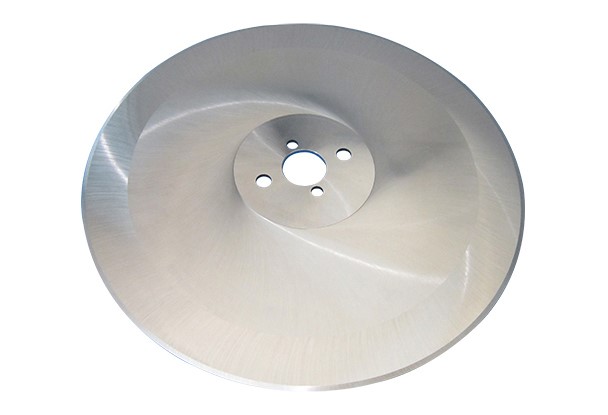The circular blades have become a fundamental element in numerous industries due to their ability to perform precise and efficient cuts. Their use ranges from wood cutting in carpentry to the metallurgical industry, including paper and cardboard production as well as the recycling sector. Present in common tools such as circular saws and grinders, as well as in continuous cutting machines, these blades stand out for their versatility and crucial role in optimizing industrial processes, enhancing productivity and the quality of work performed.
Types of Circular Blades and Their Applications in the Industry
Circular blades are manufactured in a variety of designs and materials to meet the specific needs of different industrial sectors. Depending on their structure, edge, and coating, each type of blade is optimized for certain applications, ensuring cutting precision and durability.

1. Longitudinal Cutting Circular Blades
Primarily used in the paper and cardboard industry, these blades allow for precise cuts along the length of the material. This is crucial for the production of items such as packaging, notebooks, and printed products. Longitudinal cutting blades must maintain a consistent edge to ensure continuous cutting and avoid irregular edges that could affect the quality of the final product. Generally made of high-carbon steel with the option of special coatings, these blades resist wear and extend their service life, reducing downtime in production lines.
2. Transverse Cutting Circular Blades
In the metallurgical industry, transverse cutting blades play a crucial role. They are designed to cut sheets and metal plates of varying thicknesses, from thin steel to heavier metals. These blades must withstand high cutting forces and maintain their edge during prolonged work periods. Made from tungsten carbide and other high-resistance materials, these blades ensure clean and efficient cutting, which is vital in the manufacture of metal structures and precision components. Additionally, advanced thermal treatments and coatings help improve their durability and performance under high-temperature conditions.
3. Toothed Blades
Toothed blades are particularly useful for cutting thicker or tougher materials, such as rigid plastics and wood. The teeth on the blade allow for more effective cutting by breaking down the material evenly and preventing the accumulation of debris that could interfere with the process. These blades are widely used in carpentry, furniture manufacturing, and plastic processing for the production of industrial goods. The shape and angle of the teeth can vary according to the specific application, providing a customized cutting solution for each material type.
4. Smooth Circular Blades
Smooth blades are used for precise cutting of thin materials such as plastic sheets, paper, and thin metals. These blades are essential in processes requiring a burr-free finish and perfect cutting quality to avoid material waste. They are common in the production of labels, packaging, and parts that require a high level of detail. Their straight, uniform edge allows for highly accurate cuts, and advanced coatings, such as DLC and TiAlN, can be applied to enhance wear resistance and reduce friction during cutting, contributing to greater efficiency and less maintenance.

Materials and Manufacturing Technologies
The manufacture of circular blades, as previously mentioned, involves the use of high-quality materials, such as stainless steel and high-alloy steel, along with advanced thermal treatment technologies and specialized coatings. These processes ensure that the blades not only provide efficient cutting but also maintain their durability and resistance to wear. Coatings such as diamond-like carbon (DLC) and titanium aluminum nitride (TiAlN) are particularly beneficial as they extend the service life of the blades and enhance efficiency by reducing friction and heat buildup.
Benefits of Choosing Circular Blades
Choosing high-quality circular blades is a key factor in ensuring efficient and reliable performance in industrial processes. The benefits of opting for this type of blade go beyond cutting precision; they directly impact productivity, profitability, and sustainability of operations.
Greater Precision and Cutting Quality
High-quality circular blades are designed to deliver precise and uniform cuts, minimizing errors and material waste. This is particularly important in industries where defective cutting can lead to lower-quality final products and increased costs due to reprocessing. Precision cutting improves production efficiency and enables a professional finish, meeting the most demanding market standards.
Durability and Less Frequent Replacement
Durability is one of the most notable characteristics of high-quality circular blades. Made from resistant materials and subjected to advanced thermal treatments, these blades retain their edge for longer periods, even under intensive use. This reduces the need for frequent replacements and minimizes downtime, optimizing workflow and enhancing plant productivity.
Reduction of Operating Costs
Due to their longer lifespan and reduced maintenance needs, industrial circular blades help lower operating costs. While the initial investment may be higher, the long-term savings are considerable, as fewer replacements and less maintenance are needed. Additionally, the cutting efficiency reduces energy consumption, contributing to a more economical and environmentally friendly process.
Versatility and Adaptability
High-quality circular blades can adapt to a wide range of applications and material types. Whether in the metallurgical industry, paper manufacturing, carpentry, or recycling, these blades ensure optimal performance. This versatility allows companies to maximize resources and maintain flexibility in their production processes without the need for constant tool changes.
Contribution to Workplace Safety
Using well-sharpened circular blades improves safety in the workplace. Cleaner and more precise cuts reduce the risk of accidents and prevent material kickback or uneven cuts that could endanger operators. Additionally, these blades require less effort during cutting, reducing machine wear and the likelihood of mechanical failures.
Cuchillas Castillo: Quality and Durability in Circular Blades
At Cuchillas Castillo, we understand the complexity and precision involved in the manufacture of high-quality circular blades. Our commitment is to supply industrial blades that ensure optimal and long-lasting performance, even under demanding work conditions and with abrasive materials. The blades we provide are designed to withstand wear and cutting friction, ensuring efficient operation over extended periods.
To maximize durability and maintain a perfect edge, we offer specialized advice on selecting the most resistant materials. The circular blades from Cuchillas Castillo stand out for their extended lifespan, which helps minimize maintenance tasks and guarantees the optimal performance of any continuous cutting machinery. This combination of quality and technical support helps companies maintain their production processes with maximum efficiency and reliability.

If you want to learn more about our circular blades and how they can enhance the efficiency and durability of your cutting processes, we invite you to contact us and consult with our experts. We are here to advise you and provide the best solution tailored to your industrial needs.

